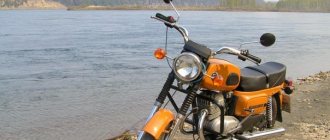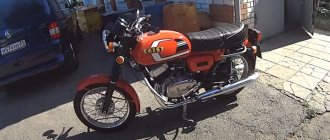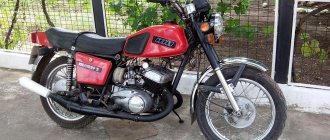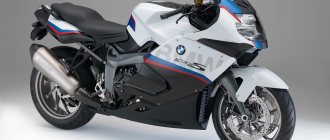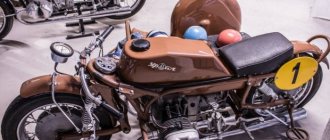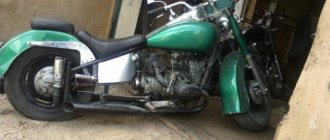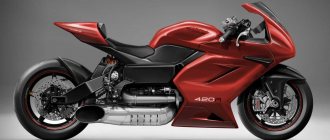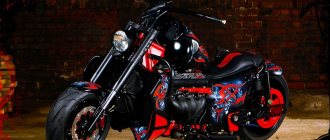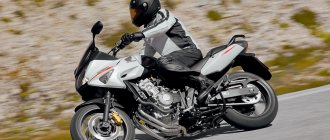In the modern world, Soviet motorcycles occupy an intermediate position between rarities and junk collecting dust in the garage, and the second is often separated from the first only by restoration. Those specimens that are lucky enough to fall into caring hands are carefully restored to a decent condition, but all the rest continue to rot peacefully somewhere in a barn. The least fortunate Soviet motorcycles fall into the hands of novice customizers and turn into “village customs” of varying degrees of horror. Below we will look at the main motorcycle manufacturers of the USSR, not in chronological order, but simply by mentioning the most iconic models. Many Soviet bikes are still alive, decades after their release, because in the USSR motorcycles were designed by engineers, not marketers, and it doesn’t matter what exactly they were - light mopeds or the most powerful representatives of the Soviet motorcycle industry. The first Soviet motorcycle, the Soyuz, assembled in 1924, laid the foundation for the future development of the industry and became a guide for the next several generations of designers.
IZ Planet Sport. The fastest and most technologically advanced.
In 1973, the Izhevsk Motorcycle Plant surprised the whole country by showing the first Soviet motorcycle with a sports bent, the Planet Sport. Unlike all earlier motorcycles, which were created in the image of German models, Planet Sport clearly tried to be similar to Japanese motorcycles of the 60s and 70s.
Due to the high quality of workmanship, IZH Planet Sport was actively sold in export markets, for example, in the UK, the Netherlands and Finland. Soviet bikers accelerated on them up to 140 km/h, which was an incredible speed in those days.
Back in the USSR. Test drive of the fastest Soviet motorcycle
“Izh Planeta-Sport” is perhaps the most unusual Soviet motorcycle. All the boys in the USSR dreamed about him. He was like a breath of freedom - modern, bright, fast... And sporty. Because he was often included in road accident reports, he was even called “Izh Planet-Death”. Yuri Gladchuk rode the legendary vehicle, risking his life.
Rock and roll in its purest form
I'm back in the USSR, you don't know how lucky you are, boys. Back in the USSR.
To understand this motorcycle, you need to play the famous Beatles song “Back in the USSR”. Because “Izh Planeta-Sport” is rock and roll in its purest form. Do not read this text without playing this music in the background. Have you turned it on? Then let's go!
Today, the decaying capitalist technologies of GoPro allow you to return to the former USSR - they filmed for you an atmospheric trip through the village on “Sport” from the first person
I don’t know what it was like in the 70s and 80s, because I was born in the last years of the Soviet Union, but I think everything was great. It was especially great for those who for a long, long time under Back in the USSR dreamed of the fastest Soviet motorcycle, and then realized their dream. And if you also had jeans with your Izhu, that’s it, you’re the first guy in the village. Although girls should “get along” with “Planet-Sport”, as the old Soviet advertising clearly hinted at. And she was right.
Beautiful motorcycle. It is completely incomprehensible how the ideological department of the party allowed him to be released. After all, it is obvious that it was created for dudes, parasites and other hooligans. Lovers of jazz and rock and roll. But they said that if you listen to jazz, it means you’ll sell your homeland.
Five interesting facts about Izh Planeta-Sport
1. When production began, the motorcycle cost about 1,050 rubles, subsequent batches began to be sold for 1,000 rubles, so not every parasite could afford it. Moreover, in those years, Moskvich-412 cost about 5,000 rubles.
2. Soviet motorcyclists gave the motorcycle the nickname “dog” (from the abbreviated “Izh PS”), “peeska” and “sportak”.
3. Due to the unusually high quality, it was rumored that Planet-Sport was intended for export to the USA. It was indeed exported and was especially loved by motorcyclists in the UK, the Netherlands and Finland.
4. “Sports” were bright yellow and orange, which, combined with the black color of the frame and the strict shine of nickel-plated parts, looked truly sporty.
5. “Izh Planeta-Sport” withstood 50-60 thousand km without noticeable wear of the main components. Very good for Soviet motorcycles.
There are legends that they allegedly complained about this motorcycle to the main ideologist of the party, Mikhail Suslov, and he tried to ban its sale. But the production of “Sport” was approved by Brezhnev, who personally rode a motorcycle. Rumor has it that Leonid Ilyich himself loved driving fast, which is probably why Izh Planeta-Sport went on sale. It’s not a fact that everything really happened like that, but the motorcycle really turned out to be hooligan.
Externally, the “dog” was very similar to Japanese motorcycles of the mid-1960s such as the Suzuki T250 Super Six, Yamaha 350R5 and Kawasaki A1 Samurai. It suited the hipsters because it was truly stylish. Look at the black round trim on the tank! The swift, light silhouette of the motorcycle immediately made it clear that the device was not intended for transporting potatoes, but for high-speed “annealing.” Even these days, when retro themes are popular in customization, “peeska” looks cool.
Before the advent of Planet-Sport in 1974, hooligans, parasites and dudes drove Czech Jawa. But the “dog” immediately pushed the “Czechs” into second place. Compared to its direct competitor Jawa 350-634, the new Izh accelerated and braked better, and had a higher maximum speed. Still, the weight was less and the horsepower was greater. Again, style, style and more style. Although there were fierce debates between fans of “javas” and “dogs” about whose motorcycle is cooler, I prefer the “Izh” - it has more rock and roll!
Damaging ties with the West
You approach the motorcycle and you are surprised. Labels for buttons on remote controls and light bulbs are in a foreign language! When you lean towards the carburetor, you see the magic word JAPAN. The vast majority of inscriptions are not in Russian, but in English. Can you imagine how cool that was at the time? There is even an emergency engine shutdown button and a light that lights up when you find “neutral.” Moreover, all the buttons are located the same as on any modern motorcycle - the remote controls are Japanese.
And this is not a “collective farm”. Early motorcycles were standardly equipped with Japanese electrical equipment, optics and a carburetor. Some parts were supplied from European motorcycles, for example, the first Izhas had a Czech ignition switch and an Italian speedometer. Even the battery was imported at first.
And the early “Planet-Sport” had a separate lubrication system. Typically, two-stroke engines are lubricated with oil, which is mixed with fuel in one ratio or another. Therefore, the amount of oil entering the engine depends only on the amount of gasoline supplied. But the early Peeski had a pump, the performance of which increased with increasing speed or load on the engine.
Memoirs of one owner of Izh Planet-Sport (taken from here)
“Excessive thrust-to-weight ratio allowed the Sport to easily stand on the rear wheel, which I often used in front of bored young ladies. And one day this trick acquired a special chic. I deliberately removed the seat belt so that the passengers would hug the driver more tightly and sensually. My comrade, who turned out to be a passenger, sat carelessly in the back and didn’t try to hug me at all - I didn’t mind. Having stopped near the girls, we casually greeted them, and I unscrew the gas handle, throwing the clutch.
The front wheel comes off normally - the motorcycle “shoots” almost beyond the horizon. I slow down, look around - and am horrified: my friend, with clouds of dust on his hands and knees, continues his fading movement behind me! There were holes in the jeans and sleeves, there was blood in the knees and elbows... But the friend was an optimist, and a drunken optimist, so they agreed to consider the sketch staged, and the performance in front of the public as successful. He didn’t ride as a passenger anymore, he began to respectfully call “Sport” “peas”, and he started calling me “mad,” especially after racing along the platform and steps of the railway station.”
Over time, Izh Planeta-Sport lost both imported components and the separate lubrication system. Due to the replacement of the Mikuni carburetor with the domestic K-62M, the maximum power decreased from 32 to 28 hp. Therefore, motorcycles from the first years of production, which had all this, were especially valued. And the early “dogs” were expensive even at the age of ten. A more detailed history of changes in the technical part can be read here.
For example, our guest is a perfectly preserved motorcycle from 1978. with a mileage of only 15,000 km and in “original” paint. The previous owner himself changed the carburetor from Soviet to Japanese. The rear light is already Soviet. But the turn signals, headlights and remote controls are imported. There is no longer a separate lubrication system, just as there are no rubber engine mounts of early copies. Not the same pie, of course, but still a very cool motorcycle. Why? Now let's start it up and tell you.
Triple purpose motorcycle
You'll do some magic with your paw, start this miracle motorcycle, and you'll smile from ear to ear. Even for me, whose childhood was spent in the 90s, nostalgia mode turns on, because the sound of a two-stroke engine is the sound of my childhood!
Rumor has it that starting it was not as easy as its Czech competitor. Yes, there is such a nuance, especially when it’s “cold”. You will also get feedback from the “kick”, tea, not a modern electric starter. But when you start it, your pants are full of delight!
For the USSR of that time, this was a very fast motorcycle. The 340cc “single-barrel” two-stroke originates from motocross bikes, so it turns easily, “explodes” at mid-range speeds and rides happily at the “top”. Despite its age, it quickly reached 120 km/h, with some room left to accelerate to the official 140 km/h.
Yes, according to the passport, the Peeska reaches “hundred” in 11 seconds, but subjectively the motorcycle accelerates faster. In the conditions of modern city traffic, you will definitely be the first among the cars. On the highway, 100-110 km/h goes without much “strain”, except that the wind blows away both the motorcycle (the light weight affects it) and the motorcyclist (there is no windshield). But I don’t see anything bad in this - everything together adds a sharpness to the sensations.
If you mentally transport yourself on it to the Soviet Union of the 1970s, remember what kind of equipment Soviet people used to move around, then you understand that “Izh Planet-Sport” is really “Izh Planet-Death”. Too much dope and too little weight: Shaitan-arba, not a motorcycle!
At the same time, there is really no equipment, there are few good roads, not all cars have scanty mirrors, and if they do, it is only on the left. It’s good that there were many fewer of these cars than there are today. But in any case, the Izh Planet-Sport is a deadly fast motorcycle for the Soviet Union.
But in modern times, 32 forces is nothing. Modern sportbikes have become “fat” and have become many times more powerful, so the lightweight Izh feels like a bicycle compared to them. It is very easy to operate. At low speeds there is no light, of course, but the motorcycle moves - even a beginner can get on.
The seat is comfortable: the seat is straight - everything is just right. The only thing is that it’s not very convenient to press such a thin tank with your knees, but this is a matter of habit. Also, all Soviet motorcyclists unanimously complained about vibrations, saying that there were none in Jawa. But I often ride “single-barrel” vehicles, so I didn’t feel much discomfort.
Brakes? They are a little bit - that's all I can say about them. The rear one is still something, but the front one needs to be pressed with all your might. Gear shifts are not the clearest. But I compare it with modern technology, and for those times everything was good with the brakes and gear shifting.
Today you are surprised by something else - versatility. And in the city you can show off with it, and you drive quickly on asphalt, and in the absence of roads there are no problems. Light weight, short first gear, strong fork, short wheelbase - easy to ride even on rough terrain. Yes, the rear suspension is a bit stiff, the clearance is small - after all, this is far from a modern enduro. But at one time, in the fields and forests at Planet-Sport, they had a blast!
At the same time, you drive over bumps, you drive fast, but nothing rattles or falls off, as in some modern “Chinese” cars. In general, there are no extraneous sounds in the pits. None. “Izh” does not “walk” under you, it feels solid and solid. In general, for Soviet technology this is a very high-quality motorcycle.
“Izh Planeta-Sport” is not only a dual-purpose, but a triple-purpose motorcycle!
1. “To show off.” I put on jeans, got on a fashionable bike, went to a country club - all Masha is yours. The main thing is not to knock on the helmet, which is flimsy in appearance and touch - they never liked “majors”.
2. Good on asphalt. Considering the dynamic characteristics of cars and motorcycles of the USSR, “Izh Planeta-Sport” compared to them is the most sportbike.
3. The motocross heritage of the Izh-55 is felt in the motorcycle - it is not afraid of rough terrain. This is also facilitated by the very low weight - only 135 kg of “dry” mass. On the basis of Planet-Sport, in April 1975, the production of sports motorcycles for the multi-day enduro “Izh M-15” and the cross modification “Izh-K-15” began.
But the music did not play for long - in 1985 the motorcycle was discontinued. Why it was removed is unclear. Some say that due to low demand, they say, the quality has become lower, but the price has remained the same, others refer to the high mortality rate of pilots, and others - to the fact that the State Traffic Inspectorate could not catch up. Tales and legends have always surrounded this motorcycle.
Who wants Back in the USSR, today this can be done with the help of the Izh Planeta-Sport time machine - they still appear in advertisements. Mix gasoline with oil, start it with your paw, and start it the first time - and into the field, at sunset, inhaling the aroma of summer deeply.
What could be better? There's nothing better.
Yuri GLADCHUK Photo and video of Anton SHELKOVICH ABW.BY
The editors thank Nikolai Melnikov for providing Izh Planeta-Sport for the test
Notes in the margins
Everything is progressive in the Planet-Sport, but there is no side step. For some reason, the “eye” of the central footrest is on the right side.
For a Soviet motorcycle there are a lot of light bulbs. All inscriptions are in a foreign language. As a child, it was of great importance what speed the speedometer of a particular type of transport was lined up to. In Planet-Sport everything is fair: the speedometer shows a maximum of 140 km/h - the motorcycle goes 140 km/h. For beginner motorcyclists, it is clearly indicated at what speed to change the next gear.
The only Russian inscription visible on the motorcycle is “Izh”, everything else is in English, including the model name PLANETA-SPORT 350.
The sides are unscrewed with a simple “twist”; the saddle, under which there was a scarce imported battery, was not locked. Steering wheel locking only appeared at the end of 1978. Before that, take it - I don’t want it.
The bike has an on-board 12-volt power supply. The Czech competitor at that time could only boast 6 volts.
The official range is 400 km, which is very good. I haven't actually tested it. The tank volume is 14 liters, while fuel consumption is documented to range from 3.5 to 6.5 liters, depending on speed and driving style.
Different sized wheels (19 inches front, 18 rear) and brake drums - this was very unusual at that time.
On this occasion, we invite you to the largest retromoto festival in Eastern Europe, “Kola Chasu”. Perhaps Planet-Sport will also come there - today it is a rare and exclusive motorcycle. In any case, about 200 pieces of rare equipment will be collected in one place - there will be something to see. And not just to look. The festival will have a recreation area, a food court, a running and cycling area for children, rental of catamarans and boats, a shooting range, a test drive of the M1NSK motorcycle and other entertainment. In addition, there will be an opportunity to purchase both antiques or even retro equipment, as well as modern motorcycles. So, the Rowing Canal on the Zaslavsky Reservoir, June 25. Come with the whole family - it will be interesting! More information about the festival can be found here.
Sunrise. The most rustic.
Voskhod motorcycles began to be produced in the city of Kovrov, Vladimir region, in 1957.
These were very unpretentious single-cylinder motorcycles (173.7 cm3 engine). The Dyagterev plant constantly improved this model, releasing onto the market after the Voskhod its modernized versions, Voskhod-2, Voskhod-3, Voskhod-3M. The latest Voskhod motorcycle was the 3M-01 model with a 15 hp engine. Because of their reliability, Voskhod motorcycles became real workers in thousands of Soviet villages. Even now you can easily find a Voskhod motorcycle in good condition there.
M-62. Choice of police.
The Soviet police, fair and incorruptible, in the 50s-60s mostly traveled on motorcycles with sidecars.
The M-62, produced by the Irbit Motorcycle Plant, was the most popular choice of servants of the law. Its four-stroke engine produced 28 hp. An interesting fact is that ordinary citizens of the USSR were not allowed to operate Urals without a sidecar at that time. Still, these motorcycles were quite difficult to control. But the police used motorcycles without sidecars, which looked very cool in the eyes of Soviet boys. How can you not want to become a policeman!
Magazine
The series features the entire motorcycle culture of the Land of the Soviets. The magazines will tell you both about the history of the motorcycle industry, as well as about the characteristics of the heroes of the issues, their modernizations and, of course, interesting facts. The publishing house cooperates with the columnist of the Moto magazine, Alexander Vorontsov, as well as with the director of the State Irbit Motorcycle Museum, Alexander Bulanov, so the content is distinguished by a professional look, and the photo content is original.
M-1A "Moscow"
Let's try to build this excursion into the motorcycle past of a great country in chronological order. Let's take the post-war period, well, simply because it is clearer and closer to us.
The motorcycle industry was revived on the basis of the best examples of captured equipment. And a lot of it was brought to the USSR. And now at the Moscow Bicycle Plant they are mastering the production of a copy of the German motorcycle DKW RT125 with a 125 cc engine.
The device is called M-1A “Moscow”. This is the first post-war motorcycle of the USSR - simple and lightweight, which did not require a lot of metal and rubber.
Motorcyclists were trained on this type of equipment in DOSAAF schools. In 1951, production was transferred to Minsk to a newly built bicycle plant. Almost the same model with the index K-125 was produced in Kovrov.
Minsk
Some USSR motorcycle models were produced at MMVZ, a plant located in Minsk, the capital of the modern Republic of Belarus. “Minski” were cheaper than the products of the Degtyarev plant, and were also very popular. Motorcycle tourists rode them all over the Union, and this technology was very good for its time. However, later the plant still stopped producing its own bikes, completely switching to assembling new models from Chinese components, which are now sold throughout Russia. But the old 125 cc Minsk still often comes up in the memory of old-school bikers if you ask them a question about the best Soviet motorcycle.
"Izh-49"
In 1951, production of the Izh-49 model was launched in Izhevsk. As in the case of “Moskva,” they took a captured vehicle as a basis. True, the DKW NZ 350 has undergone some improvements, which only made it better - under our brand, of course.
The motorcycle turned out to be reliable, very durable and incredibly beautiful. Even today it is able to captivate a true biker with its appearance - what a fit, what precise lines... Yes, it was a car!
The plant produced versions with a sidecar, sports versions for cross-country and road racing. Not everyone can afford to own them now: the Izh-49 has collector’s value. You can buy it for no less than 100 thousand rubles. At the same time, the price tends to rise.
"Izh Planet"
1962 The Izhevsk Motorcycle Plant is starting to assemble a fundamentally new model for itself, “Izh Planet”, which became the ancestor of a whole family that was produced until 2008 (“Izh Planet 7”).
A middle-class motorcycle created on the basis of the Izh-56 was intended for driving on roads with different surfaces. The warranty mileage of the Izh Planeta has increased by 2,000 km compared to its predecessor, and the service life of the cylinder-piston group parts has increased by one and a half times (thanks to the use of a contact-oil air cleaner).
A new gas tank, easily removable seat, and mufflers were installed. Instead of stamped front and rear wings, stamped-welded ones were used.
The Izh Planet was powered by a single-cylinder, two-stroke air-cooled engine. The crankshaft is prefabricated and pressed. Carter is of block type. The crank chamber is located in the front part, and the gearbox is located in the rear part. The crankcase consists of two halves with a connector along the middle longitudinal plane. The foot shift and kickstart pedals are located on the left side of the gearbox housing.
The motorcycle was produced until 1966, a total of 405,303 copies were produced - a fairly decent circulation for those times.
Izh
Many Soviet motocross motorcycles were produced at the Izhevsk plant, and they repeatedly took prizes in various competitions. Although this brand is familiar to the general public thanks to the “Planet” and “Jupiter” lines, since several million copies have been produced over the decades, and not all of them have already turned into a pile of rust. And it was at the Izhevsk plant that the first chopper-style motorcycle was produced - the Junker model. This happened after the collapse of the Union, but nevertheless.
M-72. The most combative
The M-72 was not the first army motorcycle in the USSR. In 1934, the assembly of the first Soviet heavy model PMZ-A-750 began, and in 1939 - the “understudy” of the British BSA and, considered to be the best pre-war motorcycle in the Union, TiZ-AM-600.
However, it was the M-72, the design of which was “spiked” from the German BMW R71 (the Wehrmacht was equipped with them), which came out in the tragic year of 1941, and was produced throughout the war. And then they seriously served the people for civilian purposes - the last copies rolled off the assembly line in 1960. From 1941 to 1945, the M-72 carried soldiers armed with anti-tank missile systems, machine guns or light mortars. From the first post-war years - and long after - these motorcycles became the main police transport. And since 1954, ordinary Soviet citizens could buy them for their needs.
“Descendants” of the M-72 were ordered by Saddam Hussein’s Republican Guard at the beginning of the 2000s. But I didn’t have time to use it, and combat motorcycles “went to the people.” At the request of customers, Iraqi auto repair shops install additional “active and passive protection” on the Urals - armor and a machine gun.
Mopeds and scooters
The list would be incomplete without Soviet mopeds such as “Karpaty” and “Riga”. Their first modifications were equipped with bicycle pedals, and were the most inexpensive form of transport, which was very popular in rural areas. And the Tula plant produced motor scooters “Tula”, “Tourist”, “Tulitsa” and a cargo “Ant” with a luggage platform and wide car wheels at the rear. The latter is generally in demand even now, despite the fact that it was discontinued a long time ago. Mopeds in the USSR became so popular mainly due to their low price and the absence of the need to obtain a driver’s license to drive them. They were usually the first motorcycles in the hands of future bikers, instilling in them a love of two wheels. The Carpathian moped was a dream for many of them, especially since it was already completely legal to ride a moped from the age of 14.
L-300 "Red October". The very first.
The very first serial Soviet motorcycle was the L-300 “Red October”.
At the beginning of 1930, Leningrad designers prepared its drawings, inspired by the most reliable bike of that time - the German DKW Luxus 300. And in the fall of the same year, the first batch of L-300 was ready.
The motorcycle was produced until 1938, and then the no less legendary IZH-8 was created on its basis. This “descendant” of the L-300 even ended up on silver coins... in New Zealand.
By the way, the name IZH-7 was borne by the same L-300s, which were produced in Izhevsk in parallel with the Leningrad enterprise “Red October”.
"Minsk M1A". First Belarusian
To this day, the “Minskachi” remains the most “popular” motorcycle in Belarus. They run along the roads of the entire former Union, and not only. But most of them, of course, are in their homeland.
Minsk motorcycles passed their half-century anniversary a long time ago (the first models already fully deserve the name “vintage”), and very soon, on July 12, they will celebrate their 61st birthday.
The first Belarusian “bike” was the Minsk M1A, which had many “relatives” not only in the USSR, but also abroad. The “ancestor” of the motorcycle was developed in 1939 by the Germans. The DKW RT125 turned out to be so successful that analogues of this motorcycle were produced under different names in 7 countries around the world, including the USA, England and Japan.
By the way, one of the old “Minsk racers” was tested in harsh conditions by one of the hosts of the famous British show Top Gear, Richard Hammond. He drove it from south to north almost all of Vietnam. CV of the charismatic “car maniac”: “This is the AK-47 among motorcycles - reliable, simple, easy to repair. It was made specifically for those countries where there are no roads.”
Jawa 350/638
Jawa 350 - 638 - the last Czech motorcycle sold in the USSR, where it also became popular. Having managed to come out just before perestroika, in 1984, this model often starred in harsh films of the late 1980s and early 1990s.
Externally, the motorcycle was relatively simple, but with a twist. The large headlight with round turn signals protruding from the sides and the dashboard wells located on top looked very harmonious.
The tank was voluminous, but had a neat shape; in the rear there were quite large pads for the driver’s knees. But the most important thing on the tank was the inscription “Jawa”.
The 638 had a double, flat seat divided in the middle by a strap for the passenger to hold onto.
The two-cylinder engine was completely open to view, all its components were clearly visible, although its openness played an important role - the engine was air-cooled.
The advantages of this motorcycle included a stylish look, which Soviet motorcycles were very far from achieving.
"Pannonia"
The Pannonia motorcycle has become another iconic motorcycle among urban youth and motorcycle tourists.
Production of Pannonia began in Budapest in 1954. "Pannonia" became the first new motorcycle of the plant. The motorcycle was equipped with a single-cylinder 250 cc two-stroke engine and a four-speed gearbox. The innovation was a closed chain drive and a duplex frame.
From 1954 to 1975, 286,959 motorcycles were delivered to the USSR. The most popular model was the Pannonia 250 TLF. Weighing 146 kg, the motorcycle produced 18 hp, was not picky about fuel, had an 18-liter tank and reliable electrics. In addition, the plant produced a model with a 350 cc engine and a sidecar. The beauty and perfection of the lines of the motorcycle still make connoisseurs of rarities look for surviving motorcycles.
In 1968, the plant produced a new motorcycle model, copied from the Yamaha YDS-2, but the USSR decided that the motorcycle was too complex and stopped exporting, after which the plant closed.
Military heritage
The outbreak of World War II significantly influenced the development of the sporting sector, since the main task for designers was now to produce the most reliable motorcycle model for the needs of the army. It was a copy of the German BMW R-71 “M-72”, which, in turn, served as a prototype for the next serial sports car – “M-75”, produced at. Engine with overhead valves and increased to 35 hp. power, which formed its basis, was released already in 1943.
At that time, engineers hardly thought about the sporting use of the new product, but, nevertheless, it was on the M-75 that one of its creators participated in the USSR championship in 1946. At the same time, this model began to be mass-produced for peaceful purposes and began to enjoy relative popularity among racers until production was discontinued.
In 1951, the M-75 was replaced by the M-75M, which logically developed the ideas of its predecessor. Almost the only unchanged part of its design was the well-proven engine; all other components, including even the frame, were gradually refined and improved. This was greatly facilitated by small-scale production, which made it possible to make changes almost instantly, mass-producing fresh, updated modifications. At the end of their existence, these were modern cars with aluminum cylinders with a cast iron liner, an improved front brake, a reinforced gearbox with a more convenient two-arm gear shift pedal, an updated carburetor, narrower and lighter fairings and other improvements.
By the way, the M-75M was always produced with a bracket for attaching a stroller, which made it possible to use it both for single races and for disciplines with a stroller. Moreover, the plant officially produced two modifications of strollers: for circuit racing (platform), for road racing (cradle).
In 1954, a new modification was released, called the M-77 (the M-76, oddly enough, existed only as a prototype in the period between the M-75 and M-75M). And if last time the main work was carried out on the periphery, now it’s the turn of engine modernization again. Its power was increased to 48-50 hp, which also resulted in an increase in the total weight of the motorcycle. Now, excluding the stroller, his weight reached 196 kg. Despite this, the model turned out to be successful and quite popular, but still became the last motorcycle produced in the USSR for circuit racing in the 750 cm3 class.
By the way, the M-80 model with a 750 cc engine also existed, but was produced on a different engine, almost simultaneously with the M-75. In 1947, it even set an absolute speed record of 172 km/h. In parallel with it, the GMZ also worked on “closing” other classes. And if in the 350 cm3 class they managed to release the relatively well-known “M-35” model, then a motorcycle with a 500 “cc” engine not only did not see the light of day, but did not even receive markings, although it was developed within the walls of the plant.
Java
Brand of road motorcycles produced in Tinec nad Sazavou (Czechoslovakia). The USSR was the main importer of Java. In total, more than a million motorcycles of various models were delivered to the Soviet Union. In Soviet times, Jawa motorcycles were considered the best available for sale in the USSR.
One of the popular names for the Java 360 model was “Java the old woman” or simply “old woman”. “Old women” with a single-cylinder engine were popularly called “chekushki”, due to their volume of 250 cubic centimeters.
There are several modifications that can be divided into motorcycles with 6V and 12V electrical equipment. The 6V version has a less powerful engine and a weak generator, but, subjectively, motorcycles equipped with 6V equipment are more beautiful. "Jawa" are motorcycles of the same class as the "Jupiter", but more pleasant to use. The most fashionable model in the USSR was the Java-368, which began to be produced in 1984. "Java" had a two-stroke two-cylinder engine with a volume of 343 cc. and a power of 26 hp, the maximum speed of the motorcycle was 120 km/h.
Jawa 360
Almost the ultimate dream of a Soviet motorized person is the Czech Jawa machine. The friendly country made sure that every third motorcyclist in the USSR rode this beauty - in total, more than a million Java cars of various models and versions were delivered to the country.
Production of a new series of Java motorcycles, models 250–623 and 350–633, distinguished by their original design, began in 1970. The motorcycles had a backbone frame and an engine with a separate lubrication system. In 1973, the Java 350–634 model with a duplex closed frame and a new engine was launched into production. The production of motorcycles with an engine capacity of 250 cm³ has ceased.
After modernization in 1984, the model received the index 638 and, with minor changes, continues to be produced to this day.
Many early examples of the motorcycle are still alive today, especially those with a fiberglass sidecar.
"Chezet"
The history of the legendary “Cezet” goes back to pre-war times, when the Czechoslovak arms factory Ceska Zbrojovka (CZ) decided to start producing motorcycles. In 1936, the plant produced prototypes of the Cheset, on the basis of which motorcycles with engines of 250 and 350 cc were later developed.
In 1960, CZ launched the Cheset motorcycles into mass production. In the USSR, CZ experienced unprecedented success. Along with the Java, this motorcycle was a success among rockers, and the black Cheset became the dream of an entire generation.
The famous cross-country Cezet was born in 1962. The motorcycle was equipped with a 250 cc single-cylinder two-stroke engine. Cheset's finest hour lasted until the end of the 60s. Racers from the USSR, Belgium and the GDR competed on it and won championships.
"PMZ-A-750"
In 1931, the development of medium and heavy motorcycles for the army and the national economy began. The first was the heavy motorcycle “NATI-A-750”. This car was a mixture of traditions: an American-type power unit was built into the chassis, made in the image of a BMW. “PMZ-A-750” was used not only in the army, NKVD units, but also in the civil service. The design of the motorcycle turned out to be durable, but very capricious. As a joke, the letters PMZ were deciphered as “Try to turn me on.”
Vyatka VP-150. Italian elegance.
The last one in our review is not a motorcycle at all, but a scooter.
The Vyatka VP-150, the prototype of which was the Italian Vespa scooter, is rightfully considered the most elegant two-wheeled vehicle in the USSR. It was a quiet and very comfortable scooter that even women could drive with ease. At the Vyatka base they made a whole range of three-wheeled scooters with various bodies, which were actively used in urban cargo transportation.
"Tula-200"
In 1986 - 1988, a very unusual motorcycle, the Tula-200, was produced in the Soviet Union, which was distinguished by wide off-road wheels. They were needed because the model was intended for hunters and fishermen.
They took the engine from the Tulitsa scooter, boosting it to 13 hp. This made it possible to accelerate to 90 km/h, although for such a device speed was not the main indicator; cross-country ability was much more important.
10,000 -12,000 thousand of these bikes were produced per year. The last one rolled off the plant's assembly line in 1996.
BONUS! 11. Riga-13. The first moped of Soviet boys.
0
Riga began producing mopeds back in 1958. Many boys dreamed that their parents would give them a moped for their birthday. This is what they did, so mopeds, and especially Riga-13, became the first vehicle for many. Riga-13 began to be produced in 1983. Equipped with a 1.3 hp engine, it accelerated to only 40 km/h. To start from a standstill and move uphill, the “biker” was recommended to help the engine by rotating the pedals. Riga-13 was produced until 1998, becoming the most popular model. A truck for everyone.
0
Based on the Tula scooters, the Tula Machine-Building Plant produced a huge number of three-wheeled cargo scooters called Ant. This was a breakthrough for the Soviet Union, because the sale of vans and station wagons to USSR citizens was prohibited. So such scooters were almost the only opportunity to transport small quantities of cargo. TMZ has produced a huge number of such scooters. They were equipped with flatbed platforms, dump bodies, vans and even tanks. They are still popular today.
ZID-175 4ShP. The first Soviet ATV.
Surprisingly, in our country, despite the complete absence of roads in some places, ATVs have never been mass produced. Almost the only more or less serial copy was the ZID-175 4ShP, produced at the Dyagterev Plant.
The design was not very successful: weak engine, complex transmission elements. This is probably why such ATVs are not widely used.
ZiD
The Degtyarev plant located in Kovrov has been producing motorcycles for decades. At first it was the “Kovrovtsy”, then they were replaced by the “Voskhod”, which were further developed in the form of the “Owl” and “Courier” motorcycles. 50-cc “Pilot” and “Active” devices were also produced, which differed from mini mopeds like “Karpaty” in the most favorable way. But later the Kovrov plant suffered the same fate as the Minsk plant - it began assembling Chinese motorcycles, actively collaborating with the Lifan company. And over the years of production, the aforementioned “Pilot” received almost cult status, head and shoulders above all mopeds of Soviet times. It was much more technologically advanced, and it looked much more interesting in appearance, which can be clearly seen from the photo. The plant also produced special equipment for Soviet athletes, and some models produced at the ZiD plant may well lay claim to the title of the fastest motorcycle of that era. Its technical characteristics were excellent, but we probably won’t give a detailed description here.
In 1958, the Kharkov bicycle factory began producing the B-901 bicycle specifically for the D-4 engine.
Compared to a regular road machine, this bike had a shock absorber in the front fork and larger tires. Apparently, the B-901 can be considered the first Soviet mass-produced motorbike. Then the production of motorbikes was transferred to the Lvov Metal Plant (since 1960, Lviv Motorcycle Plant - LMZ). In the same year, the plant began producing B-902 motorbikes, which differed from the B-901 mainly in the frame design. In 1962, the plant’s design bureau created the MV-042 “Lvovyanka” motorbike. It was a fundamentally new model with a special load-bearing all-stamped frame, telescopic front fork and even spring-loaded rear suspension.
In the first batches of the Lvovyanka, the engine was still the same - D-4.
In the process of subsequent modernization of the moped, instead of a rear fork with a central spring, they began to install double shock absorbers in aluminum casings. And, most importantly, the D-4 was replaced by a new engine - the D-5, with the compression ratio increased to 6 units. Engine power increased to 1.2 hp. at 4500 rpm, fuel consumption remained at 1.5 l/100km. The high thermal stress of the D-5 forced the designers to use a new cylinder with developed ribs and a removable head.
The “Lvovyanka” was replaced by the light moped “MV-044”, characterized by a developed hood and angular shapes.
In 1969, they began to produce a new model - “MP-045” with a reinforced frame and a larger gas tank.
The last of the light mopeds produced by the Lviv Motorcycle Plant is “MP-047” “Tisa”. After this model, the plant completely switched to the production of heavy mopeds - “Verkhovyna”, and subsequently “Karpaty”.
It should be noted that rear shock absorbers were installed on all light mopeds of the Lvov plant. Light mopeds from other Soviet factories, as well as most foreign light mopeds of those years, did not have such “luxury”.
Almost simultaneously with the plant in Lvov, the production of light mopeds was launched at the Riga motorcycle plant “Sarkana Zvaigzne” (“Red Star”) and at the Penza Bicycle Plant named after M.V. Frunze.
The running gear of the first light moped, the production of which began in Riga in 1959, was the Riga-16 men's bicycle manufactured here.
The familiar D-4 engine was installed on the bike. (A. Popov, Cooled Star, “Moto”, No. 1, 2012, p. 88). The resulting design was very reminiscent of the B-901 motorbike from the Kharkov bicycle factory.
“Verkhovyna-5” (LMZ-2.153)
It was produced since 1974 and featured a greatly modified appearance.
The moped received a horizontal tank with a capacity of 7 liters, a different trunk, and a new front fork. The Sh-57 engine was installed on the moped. In 1978, they began producing Verkhovyna-6 (LMZ-2.158) with a slightly modified design and a Sh-57 engine, and later a Sh-58 with a kickstarter.
In addition to the base model, production of “Verkhovyna-6-Sport” and “Verkhovyna-6-Tourist” was also launched. “Verkhovyna-6-Sport” was distinguished by a top-mounted muffler, a cross-type steering wheel with a jumper and a sprung front wheel guard. “Verkhovyna-6-Tourist” had a wind deflector and two spacious luggage bags behind the driver’s saddle.
One of the “Verkhovyna-6” became the two-millionth moped (!) of the Lviv Motor Plant. “Verkhovyna-7” (LMZ-2.159) - the last of the “Verkhovyna” - was produced since April 1981. The moped was equipped with a new front fork, new, more powerful lighting equipment and a new trunk.
Verkhovyna-7 was equipped with derated Sh-62(M), and later with V-50. The maximum design speed of the moped was reduced to 40 km/h.
In the spring of 1981, a model no less significant for the history of the Lviv Motor Plant appeared - the Karpaty mokik (LMZ-2.160),
0 and in 1986 the mokik “Karpaty-2” (LMZ-2.161) was released. Both Karpaty mokiks, in the development of which the VNIITE branch in Leningrad took part, were equipped with a Sh-58 or Sh-62 engine with a contactless ignition system.
If we talk about the external differences between the “Verkhovyna-7” and “Karpaty” mopeds, the most obvious is the changed shape of the frame, tank, muffler and side casings in the “Karpaty” mopeds. The developers increased the service life of the new model: the warranty mileage of the Karpaty mokik was 8,000 km (Verkhovyna-7 had 6,000), and the service life before the first overhaul was up to 18,000 km compared to 15,000 km for Verkhovyna. Like “Verkhovyna-6”, the mokick “Karpaty” also had similar modifications - the “Karpaty-Tourist” moped and the “Karpaty-Sport” youth moped. Subsequently, the Karpaty-2-Lux moped was also produced, the distinctive feature of which was direction indicators.
In 1988, the Lviv Motorcycle Plant produced 123 thousand mopeds. Once the production volumes of this plant were twice as large, however, in the second half of the 80s it was necessary to reduce the production of 50 cc cars due to a drop in demand and actively develop new models to attract buyers. A new model LMZ-2.164 was developed. In 1990, the Serpukhov Scientific Research Institute of Motorcycle Engineering designed a new modern model of the D-51 engine with a petal valve at the inlet and an automatic centrifugal clutch, which was supposed to be installed on new models of Lviv mopeds, but the engine did not go into production...
The collapse of a united country led to the death of the Lviv Motor Plant. Now on its territory there is the Inter-Sport sports complex, as well as many small companies that have nothing to do with mopeds. Summing up the Soviet stage of the history of domestic motorcycle construction, it can be noted that in the 60s and 70s, the moped was one of the most accessible vehicles for the country's population. Mopeds were produced in the millions; there was never a shortage of mopeds in the retail chain (maybe with the exception of individual models). Mopeds were also affordable. For example, in 1975, a moped “Riga-7” cost 112 rubles, “Riga-12” - 186 rubles, “Verkhovina-5” - 196 - 198 rubles (depending on the configuration). For comparison, the price of an Electron scooter was 270 rubles, a Minsk-105 motorcycle was 330 rubles, a Voskhod-2 was about 420 rubles, etc. Any worker could purchase two-wheeled motor vehicles, especially mopeds.
It is curious that, having overtaken the companies of Germany and France, which laid the foundation for the mass production of small motor vehicles, by the early 80s of the 20th century we took third place in the world (after Japan and Italy) in the production of mopeds and began to supply them to the foreign market (for example, in Hungary, Poland, Angola, Bangladesh, Cuba and even Italy). (M. Leonov, What should a youth moped be like?, “Technology for Youth”, No. 3, 1983, p. 48).

